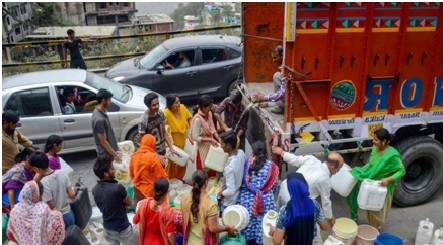Shimla, “the Queen of Hills” and capital of Himachal Pradesh is the most visited hill station. For the past few summers, the water scarcity problem has been recurring phenomenon, but nowadays, the Himalayan town facing this problem in gigantic proportion. During 2nd fourth nights of May 2018, there was an extreme scarcity of water in the town, which hit the local residents and tourism industry badly are shown in Figure no. 1.
The situation is so crucial that most of the time local residents took to roads and protesting against the water shortage problem, and asked holidaymakers to keep away from an area, as supply runs dry. Due to this water crisis, the local residents met out their water requirement through water tankers. The situation has reached the courts of Shimla and there is a new appeal being made every single day by the officials, media and the locals Shimla authorities that they have arranged 27 tankers to distribute 2.25 lakh litres of water at 63 points in the city. On 30 May 2018, the Himachal Pradesh High Court directed Municipal Corporation, Shimla not to distribute water through tankers. The High Court also ordered the state government and the Municipal Corporation to not permit any supply of water for construction of buildings and car washing. Few private suppliers twisted this water crisis into business opportunity, which fills the water from local areas and sells it at Rs.10-15 per container to the local residents and hotel industries also. Water scarcity affects various sections in the city, as the department of education has ordered the closure of government schools in the city and International Summer Festival of Shimla which is postponed by Shimla administration from 1st to 5th June 2018 due to the water scarcity.
Water resources and theirconsumption ratein Shimla
The major water sources for Shimla are Gumma, Giri, AshwiniKhad, Churta and Seo. Overall the water available from these sources amounting to about 65 million litres per day (MLD) and the demand of Shimla is around 45 MLD in Shimla. The water supply of 5 MLD from the AshwaniKhad which was the regular source to Shimla was stopped after jaundice outbreak due to contamination occurred in 2016 which reduced the supply of water to the city. There is no eternal source of water for the city but the long-term permanent key would be when over Rs 800 croreKol Dam lift drinking water scheme comes into operational, which would supply 104 MLD of water to the capital city.
Reasons behind Shimla's water crisis
Tourism industry
During the peak tourist season (April to September), on an average 15,000-20,000 travellers visit Shimla every day according to a report. The local resident population of Shimla is just about 2.2 lakh, whereas tourist arrival reaches 25,000-30,000 over the weekend, which ultimately increased the water footprint in the city. Since the shortage of the water supply, the hotels have been cancelling bookings and locals are using social media to ask tourists to stay away until supplies recover.
Environmental changes in Shimla
The adverse changes in environment and their climate are responsible for the depletion of water resources around the city which have impact on both water amounts in the landscape. The irregular land usage pattern in hilly region disturb the water holding capacity of the landscape, deforestation or trees loss on steep hillsides caused the water run-off, but mostly through change in precipitation/rainfall patterns like unusual and insufficient rainfall in last few months. Processes like higher glaciations and changes in the snow melt affect the water balance in a Shimla. For example: If we talk about last winter months there was also lower precipitation than normal, which made the water sources to dry. Less retention capacity of water through usual water ecosystem led to residual water that cannot be harvested properly. As a result, freshwater availability is abating and the most of wastewater is increasing and causing further water resources contamination.
Buildings arrangement in Shimla
The building construction is generally a matter of concern in the city for the water crisis. The kind of infrastructure that is put for drains and houses is such that water gushes rapidly and retained hardly. Catchment areas are necessary to be shaped around aquatic bodies to promote natural recharging.
Poor management system
The poor management system, for instance, old and leaky pipes which cause loss of a significant amount of water. During the distribution of water, the municipal body is often irregular and partial with local residents who are getting drinking water supply after four to five days in the majority of localities and give special treatment to VVIP localities. There is a shortage of distribution personnel who have to cover more than 2 km of an area to manage the distribution sites. Construction of illegal buildings that takes place across the city where water is normally pilfered for use, alongside with hotels that draw extra water and thus the rest of the locals are left with the water shortage problem.
Suggestive Measures
This summer, the shortage of water supply in Shimla is major problem as a result of population explosion, decreasing precipitation/rainfall etc. In order to reduce the further risk and for sufficient water supply there are few recommendations like construction of small check dams and creation of water reservoirs, construction of rainwater harvesting plants with financial support from local Municipal Authorities, proper management of water scheme, investment in the ecological and physical infrastructure, control on illegal constructions, water literacy programmes should be organized by Co-ordinator of various institutions in association with NGO‟s, involvement of media/digital technologyto aware on mass level about waterconservation. As the fresh water is considered to be a limited resource and its pollution by human activity is not enviable focus on recycling and harvesting water, having better testing and purification facilities. It is therefore, we should call an urgent attention to deal with water pollution problem, also.
